MSI 970 Gaming Motherboard Review: Undercutting AM3+ at $100
by Ian Cutress on January 22, 2015 10:00 AM EST- Posted in
- Motherboards
- AMD
- MSI
- Vishera
- AM3+
System Performance
Power Consumption
Power consumption was tested on the system while in a single MSI GTX 770 Lightning GPU configuration with a wall meter connected to the OCZ 1250W power supply. This power supply is Gold rated, and as I am in the UK on a 230-240 V supply, leads to ~75% efficiency > 50W, and 90%+ efficiency at 250W, suitable for both idle and multi-GPU loading. This method of power reading allows us to compare the power management of the UEFI and the board to supply components with power under load, and includes typical PSU losses due to efficiency. These are the real world values that consumers may expect from a typical system (minus the monitor) using this motherboard.
While this method for power measurement may not be ideal, and you feel these numbers are not representative due to the high wattage power supply being used (we use the same PSU to remain consistent over a series of reviews, and the fact that some boards on our test bed get tested with three or four high powered GPUs), the important point to take away is the relationship between the numbers. These boards are all under the same conditions, and thus the differences between them should be easy to spot.
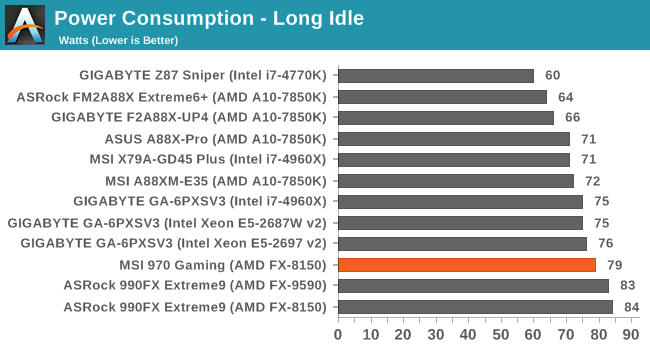
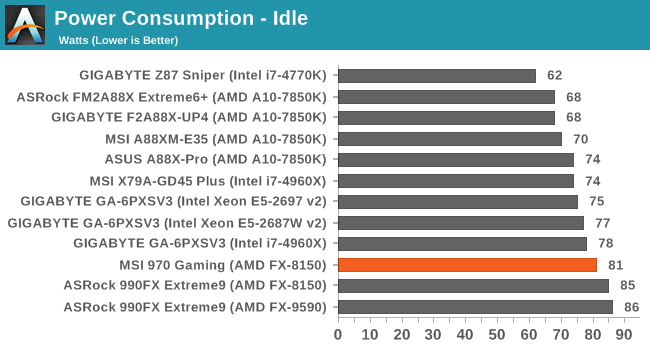
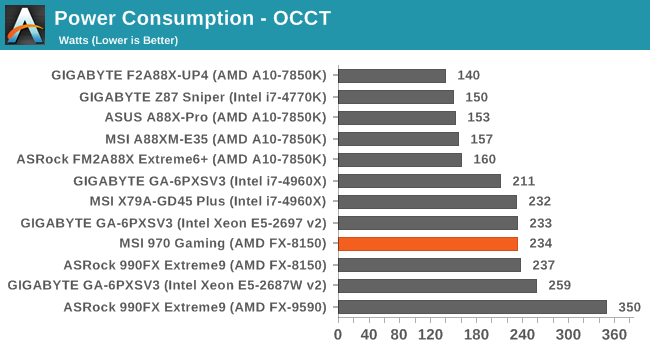
Compared to our 990FX counterpart in the similar test, the 970 Gaming does better at idle, but is relatively evenly matched at load, with the difference equating almost equally to the TDP difference of the chipsets.
Windows 7 POST Time
Different motherboards have different POST sequences before an operating system is initialized. A lot of this is dependent on the board itself, and POST boot time is determined by the controllers on board (and the sequence of how those extras are organized). As part of our testing, we look at the POST Boot Time using a stopwatch. This is the time from pressing the ON button on the computer to when Windows 7 starts loading. (We discount Windows loading as it is highly variable given Windows specific features.)
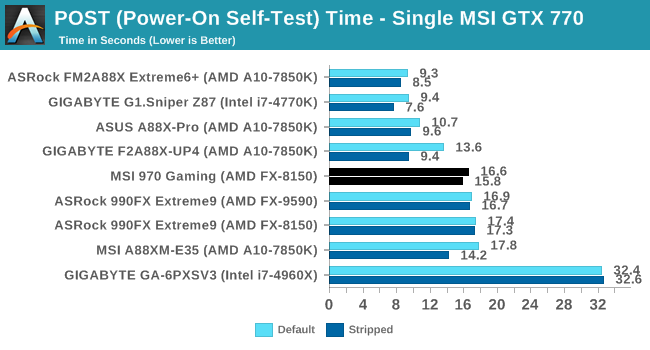
The 970 Gaming has a small leg up against the 990FX during POST.
Rightmark Audio Analyzer 6.2.5
Rightmark:AA indicates how well the sound system is built and isolated from electrical interference (either internally or externally). For this test we connect the Line Out to the Line In using a short six inch 3.5mm to 3.5mm high-quality jack, turn the OS speaker volume to 100%, and run the Rightmark default test suite at 192 kHz, 24-bit. The OS is tuned to 192 kHz/24-bit input and output, and the Line-In volume is adjusted until we have the best RMAA value in the mini-pretest. We look specifically at the Dynamic Range of the audio codec used on board, as well as the Total Harmonic Distortion + Noise.
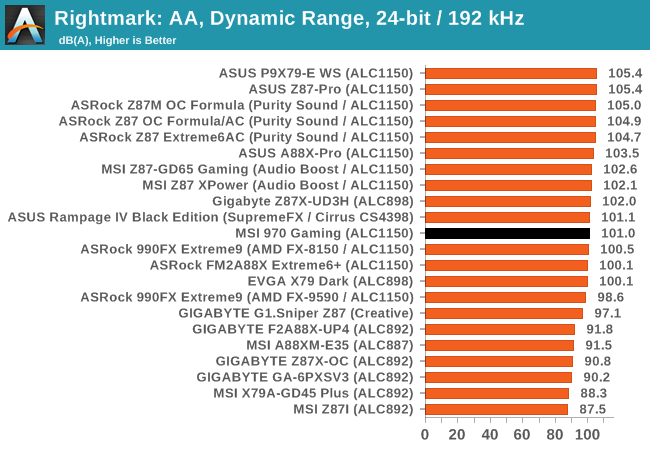
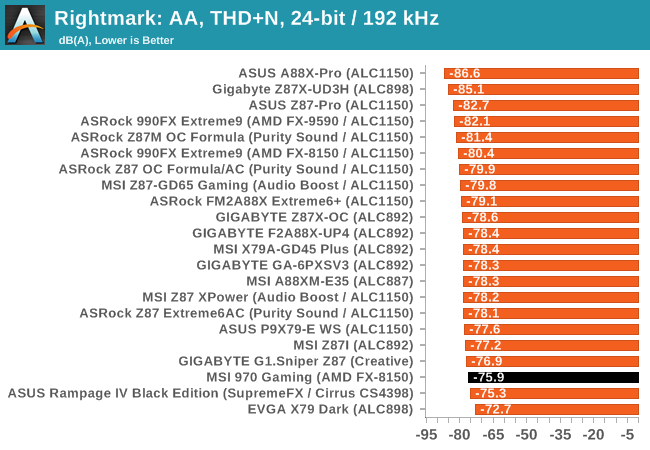
MSI’s board does slightly better in dynamic range, but falls behind a fair bit in THD+N.
USB Backup
For this benchmark, we transfer a set size of files from the SSD to the USB drive using DiskBench, which monitors the time taken to transfer. The files transferred are a 1.52 GB set of 2867 files across 320 folders – 95% of these files are small typical website files, and the rest (90% of the size) are small 30 second HD videos. In an update to pre-Z87 testing, we also run MaxCPU to load up one of the threads during the test which improves general performance up to 15% by causing all the internal pathways to run at full speed.
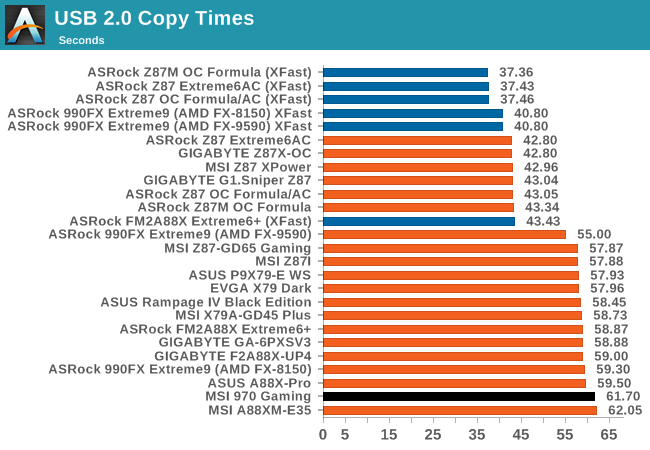
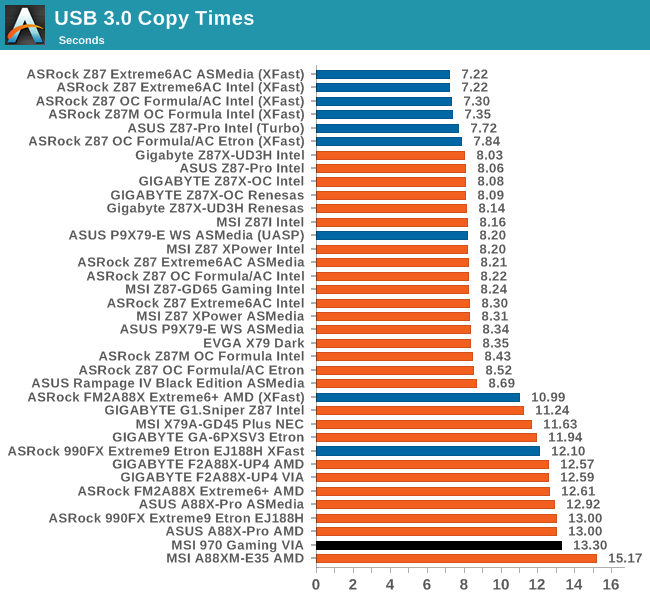
The 970 Gaming is not the best USB performer around.
DPC Latency
Deferred Procedure Call latency is a way in which Windows handles interrupt servicing. In order to wait for a processor to acknowledge the request, the system will queue all interrupt requests by priority. Critical interrupts will be handled as soon as possible, whereas lesser priority requests such as audio will be further down the line. If the audio device requires data, it will have to wait until the request is processed before the buffer is filled.
If the device drivers of higher priority components in a system are poorly implemented, this can cause delays in request scheduling and process time. This can lead to an empty audio buffer and characteristic audible pauses, pops and clicks. The DPC latency checker measures how much time is taken processing DPCs from driver invocation. The lower the value will result in better audio transfer at smaller buffer sizes. Results are measured in microseconds.
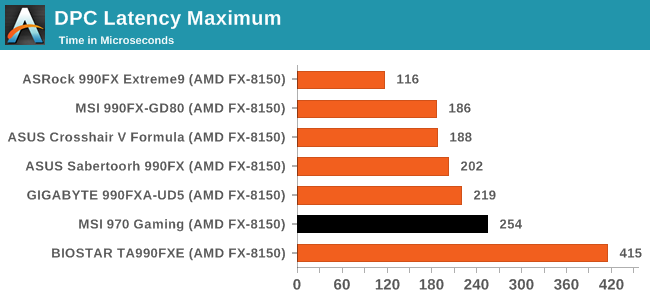
The DPC Latency is often an afterthought for cheaper motherboards, and the 254 microsecond result confirms this. This puts it in the middle of the pack for 900 series boards in general.










37 Comments
View All Comments
Samus - Thursday, January 22, 2015 - link
Not a bad price for such a complete board, even if the chipset is 4 years old.R3MF - Thursday, January 22, 2015 - link
the new asrock 970 fatality board looks better to be frank.no silly atheros 'killer' network cocket with dubious linux support
20Gb/sec m.2 slot
support for 220W CPU's
Ranari - Thursday, January 22, 2015 - link
I'm going to chalk this up as me being a terrible reader, but I was confused reading this review. Does this motherboard support 220W CPUs or not? Or is it limited to just 125W range?silverblue - Thursday, January 22, 2015 - link
Ian pointed this out to AMD; I doubt it does. It does support up to and including the 8370 though if their compatability list is to be believed.I'm not sure who'd want to throw a 220W CPU into any board let alone a 970, though.
FlushedBubblyJock - Sunday, February 15, 2015 - link
I ran a dedicated 10guage Romex line, 30 amper, to my 4.23 Vishy w/ my OC 290X and all was good my killawatt was reading 890wattts but then it tore down my 3000joule clamping voltage surge protector. :-(Luckily I had the fire extinguisher handy just in case.
Killrose - Thursday, January 22, 2015 - link
I beleive MSI is getting 2 x 8 PCI-e for SLI / Crossfire out of the 970 chipset on this motherboard although it is not supported by AMD, is this true?frenzy55 - Wednesday, January 28, 2015 - link
Yes this is true, this mobo supports SLI and Crossfire.failquail - Friday, January 23, 2015 - link
Could be a nice cheap replacement for my current motherboard that is experiencing a slow and painful death.(Asus Crosshair IV formula, AMD 890FX
Current status:
8/12 of the USB2 ports non-functional
USB3 ports dead
RAID controller dead
Jmicron ESATA/SATA extra controller dead
The rest of the board is still going, but i'm unsure how long for...)
Regarding the killer NIC: does this simply function as a standard LAN port if you don't install their software?
tekphnx - Friday, January 23, 2015 - link
Voltage by offset only, and no LLC, on a 'gaming' motherboard, is very disappointing. For $100, this board's other shortcomings could be forgiven, but as it stands, one would do better to stick to a standard 970 board at around $85. As for 990FX, unless someone already owns a 6000 or 8000 series CPU, investing $130+ for a 990FX board on the rather dated AM3+ platform at this point is a pretty foolish move vs. what Intel has to offer.MrFrogSD - Monday, January 26, 2015 - link
As someone who prefers smaller (read mATX) systems, it's been a real disappointment that no one has come out with any decent AM3+ mATX motherboards in the last several years. For those of us with limited space, we're pretty much forced to use FM2 or Intel at lower performance or higher cost.